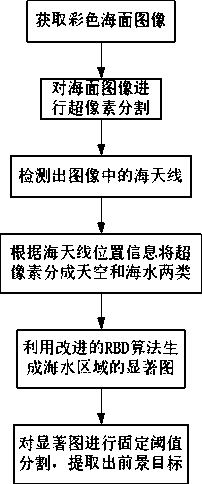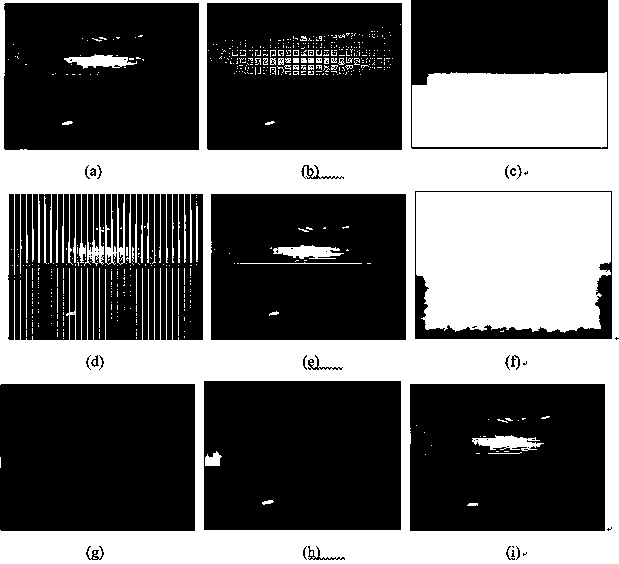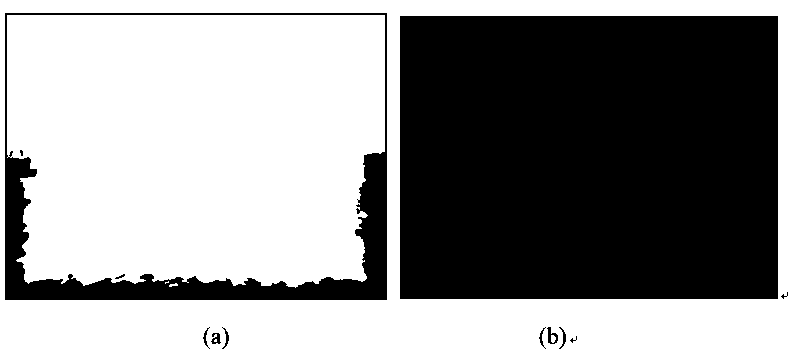Sea surface target detection method based on improved RBD significance calculation
A target detection and saliency technology, applied in the field of image processing, can solve problems such as poor real-time performance, large amount of calculation, and small saliency value, and achieve the effects of reducing the number of superpixels, improving accuracy, and shortening processing time
- Summary
- Abstract
- Description
- Claims
- Application Information
AI Technical Summary
Problems solved by technology
Method used
Image
Examples
Embodiment 1
[0064] A sea surface target detection method based on the improved RBD saliency calculation disclosed in the present invention is illustrated below with an example. The present embodiment adopts C++ programming language and OpenCV storehouse to realize, and concrete implementation steps are as follows:
[0065] (1) Obtain the original color sea surface image;
[0066] The original sea surface image is a 24-bit color image with a resolution of 640x480, such as figure 2 as shown in a;
[0067] (2) Using Simple Linear Iterative Clustering Algorithm (SLIC) to over-segment the image to generate SLIC superpixels;
[0068] Use the SLIC algorithm to perform superpixel segmentation on sea surface images, such as figure 2 as shown in b. Among them, the number of expected superpixels is set to 500, and the final number of superpixels generated may be slightly less than 500 according to the actual pixel distribution of the image, such as figure 2 as shown in b.
[0069] (3) Using...
Embodiment 2
[0080] The improved algorithm proposed by the present invention eliminates the target superpixels in contact with the image boundary due to screening the boundary set Bnd of the RBD algorithm, thereby improving the problem that the RBD algorithm is not sensitive to the target area at the image boundary. In order to verify the effectiveness of the present invention in improving the RBD algorithm, in this embodiment, except that the boundary set Bnd is not screened, other specific implementation steps are the same as those in Embodiment 1, so details are not repeated here.
[0081] image 3 a and image 3 b are the image boundary and the corresponding saliency map of the seawater area extracted by the RBD algorithm, respectively. It can be seen that the image boundary extracted by the improved algorithm in this paper is more reasonable, and the saliency map obtained based on it is also more accurate.
PUM
 Login to View More
Login to View More Abstract
Description
Claims
Application Information
 Login to View More
Login to View More - R&D
- Intellectual Property
- Life Sciences
- Materials
- Tech Scout
- Unparalleled Data Quality
- Higher Quality Content
- 60% Fewer Hallucinations
Browse by: Latest US Patents, China's latest patents, Technical Efficacy Thesaurus, Application Domain, Technology Topic, Popular Technical Reports.
© 2025 PatSnap. All rights reserved.Legal|Privacy policy|Modern Slavery Act Transparency Statement|Sitemap|About US| Contact US: help@patsnap.com



